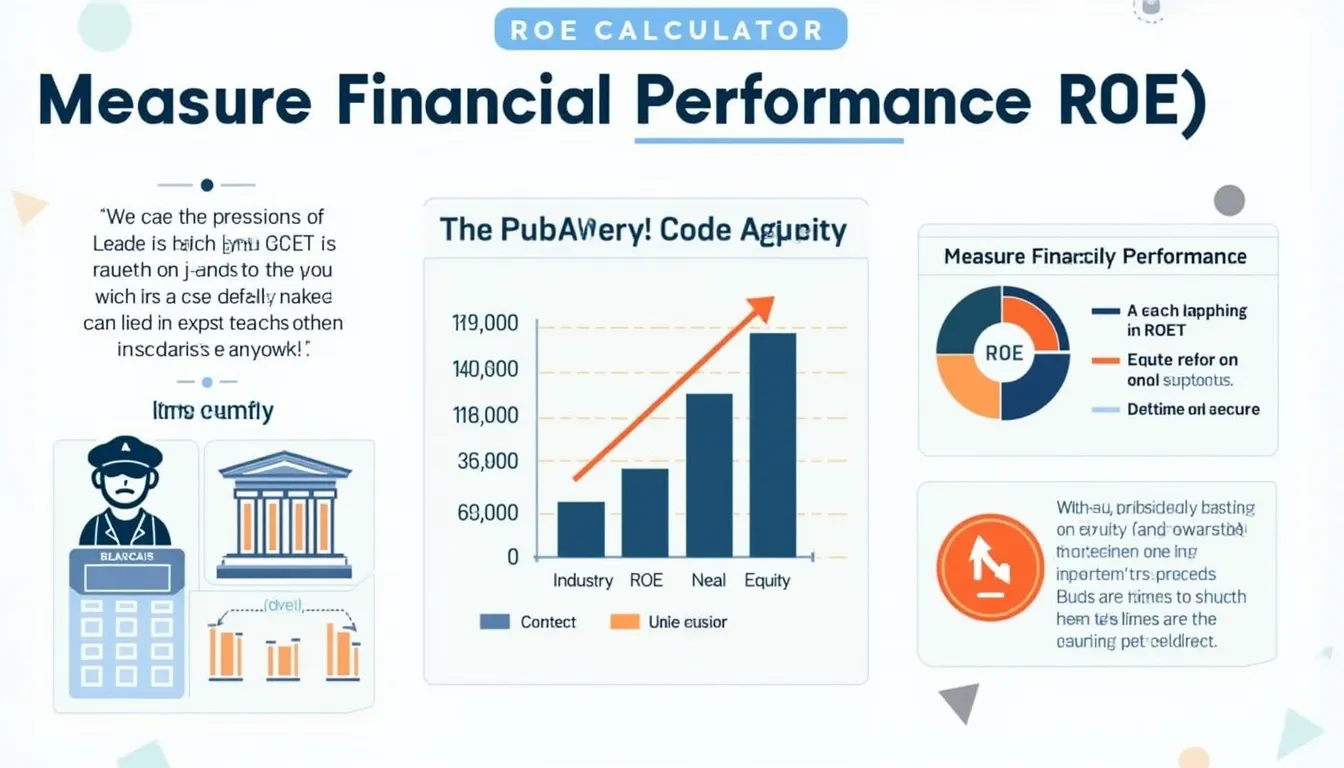Return on Equity (ROE) Calculator
Is this tool helpful?
How to Use the Return on Equity Calculator Effectively
Our Return on Equity (ROE) Calculator is a powerful tool designed to help investors, financial analysts, and business owners quickly assess a company’s profitability relative to its shareholders’ equity. To use the calculator effectively, follow these simple steps:
- Enter the company’s Net Income for the period in the first input field.
- Input the Average Shareholder Equity for the same period in the second field.
- Click the “Calculate ROE” button to generate the result.
- The calculator will display the ROE as a percentage, providing an instant insight into the company’s financial performance.
Remember, for accurate results, ensure that both Net Income and Average Shareholder Equity figures are from the same time period, typically a fiscal year or quarter.
Understanding Return on Equity: Definition, Purpose, and Benefits
Return on Equity (ROE) is a crucial financial metric that measures a company’s profitability in relation to its shareholders’ equity. It’s calculated using the following formula:
The purpose of ROE is to reveal how effectively a company is using its shareholders’ investments to generate profits. A higher ROE generally indicates better financial performance and more efficient use of equity capital.
Key benefits of understanding and calculating ROE include:
- Assessing management’s efficiency in utilizing company resources
- Comparing profitability across different companies or industries
- Identifying potential investment opportunities
- Tracking a company’s financial performance over time
- Helping in making informed financial decisions
Benefits of Using the ROE Calculator
Our Return on Equity Calculator offers numerous advantages for users seeking to analyze financial performance:
1. Time-Saving Efficiency
Instead of manually performing calculations, our tool instantly computes ROE, saving valuable time for busy professionals and investors.
2. Accuracy and Reliability
The calculator eliminates human error, ensuring precise results every time you input your financial data.
3. User-Friendly Interface
With a clean, intuitive design, our calculator is accessible to users of all experience levels, from financial novices to seasoned experts.
4. Real-Time Analysis
Get immediate results as you input different figures, allowing for quick comparisons and scenario analyses.
5. Mobile Compatibility
Access the ROE Calculator on-the-go from any device, making it convenient for professionals who need to perform calculations outside the office.
6. Educational Tool
For students and those new to finance, the calculator serves as an excellent learning aid to understand the relationship between net income and shareholder equity.
Addressing User Needs and Solving Specific Problems
The ROE Calculator addresses several key user needs and solves specific problems in financial analysis:
Quick Performance Assessment
For investors and analysts who need to rapidly evaluate a company’s profitability, our calculator provides instant results, facilitating faster decision-making processes.
Comparative Analysis
By easily calculating ROE for multiple companies, users can efficiently compare the financial performance of different entities within an industry or across sectors.
Trend Identification
Financial professionals can quickly input data from different periods to track ROE trends over time, helping to identify patterns in a company’s financial health.
Investment Screening
Investors can use the calculator as a preliminary screening tool to identify potentially attractive investment opportunities based on ROE performance.
Management Efficiency Evaluation
Business owners and executives can assess how effectively they’re utilizing shareholders’ equity to generate profits, informing strategic decisions and resource allocation.
Financial Reporting Support
Accountants and financial reporters can swiftly verify ROE calculations for accuracy in financial statements and reports.
Practical Applications and Use Cases
To illustrate the practical applications of our ROE Calculator, consider the following use cases:
1. Investor Due Diligence
An individual investor is considering purchasing stocks in two technology companies. Using the ROE Calculator, they input the net income and average shareholder equity for both companies:
- Company A: Net Income = $1,000,000, Average Shareholder Equity = $5,000,000
- Company B: Net Income = $800,000, Average Shareholder Equity = $3,000,000
The calculator reveals:
- Company A ROE: 20%
- Company B ROE: 26.67%
This quick analysis shows that Company B is generating a higher return on equity, potentially making it a more attractive investment option.
2. Financial Analyst Comparison
A financial analyst is preparing a report on the banking sector. They use the ROE Calculator to compare the performance of several major banks:
- Bank X: ROE = 15.3%
- Bank Y: ROE = 12.8%
- Bank Z: ROE = 17.5%
This rapid calculation allows the analyst to quickly rank the banks by profitability relative to shareholder equity, forming the basis for a more in-depth analysis.
3. Business Performance Tracking
A small business owner wants to track their company’s ROE over the past three years:
- Year 1: Net Income = $50,000, Average Shareholder Equity = $200,000, ROE = 25%
- Year 2: Net Income = $60,000, Average Shareholder Equity = $220,000, ROE = 27.27%
- Year 3: Net Income = $75,000, Average Shareholder Equity = $250,000, ROE = 30%
By using the calculator for each year, the owner can easily visualize the improving trend in their company’s ROE, indicating growing efficiency in utilizing shareholder equity.
4. Academic Research
A finance student is conducting research on the automotive industry. They use the ROE Calculator to analyze the performance of major car manufacturers over the past decade. This allows them to quickly identify which companies have consistently delivered the highest returns to shareholders, forming the basis for their thesis on industry trends and management effectiveness.
5. Merger and Acquisition Analysis
An investment bank is advising on a potential merger between two retail chains. Using the ROE Calculator, they can swiftly assess the current profitability of both companies relative to their equity. This initial analysis helps in determining the potential synergies and valuation for the merged entity.
Frequently Asked Questions (FAQ)
Q1: What is a good Return on Equity (ROE)?
A: Generally, an ROE of 15-20% is considered good, but this can vary by industry. It’s best to compare a company’s ROE to its industry average or historical performance.
Q2: Can ROE be negative?
A: Yes, ROE can be negative if a company reports a net loss or has negative shareholder equity. However, negative ROE is usually a red flag indicating financial distress.
Q3: How often should I calculate ROE?
A: For publicly traded companies, it’s common to calculate ROE quarterly or annually, aligning with financial reporting periods. For private businesses, annual calculation is typically sufficient.
Q4: Is a higher ROE always better?
A: While a higher ROE generally indicates better profitability, extremely high ROE might signal unsustainable performance or financial risk. It’s important to consider other financial metrics alongside ROE.
Q5: How does ROE differ from Return on Assets (ROA)?
A: ROE measures profitability in relation to shareholder equity, while ROA measures profitability relative to total assets. ROE focuses on how efficiently a company uses its equity financing, while ROA considers all assets regardless of financing method.
Q6: Can I use the ROE Calculator for any type of business?
A: Yes, the ROE Calculator can be used for any profit-making entity. However, interpretation may vary for different industries and company structures.
Q7: How does debt affect ROE?
A: Higher debt levels can inflate ROE by reducing shareholder equity. This is why it’s important to consider a company’s debt levels when interpreting ROE.
Q8: Is ROE the same as the company’s stock return?
A: No, ROE measures the company’s internal profitability relative to equity, while stock return includes market price changes and dividends, which are influenced by various external factors.
Conclusion: Empowering Financial Analysis with the ROE Calculator
The Return on Equity Calculator is an invaluable tool for anyone involved in financial analysis, investment decision-making, or business performance evaluation. By providing instant, accurate ROE calculations, it empowers users to:
- Quickly assess a company’s profitability and efficiency
- Make informed investment decisions
- Compare performance across companies and industries
- Track financial trends over time
- Support comprehensive financial analysis
Whether you’re an investor, financial analyst, business owner, or student, our ROE Calculator simplifies the process of evaluating financial performance, saving time and ensuring accuracy in your calculations.
Take advantage of this powerful tool today to enhance your financial analysis capabilities. Start by inputting your financial data into the calculator above and gain instant insights into company profitability and efficiency. Remember, while ROE is a crucial metric, it should be used in conjunction with other financial indicators for a comprehensive understanding of a company’s financial health.
Empower your financial decision-making with our Return on Equity Calculator – your key to unlocking valuable insights into company performance and investment potential.
Important Disclaimer
The calculations, results, and content provided by our tools are not guaranteed to be accurate, complete, or reliable. Users are responsible for verifying and interpreting the results. Our content and tools may contain errors, biases, or inconsistencies. We reserve the right to save inputs and outputs from our tools for the purposes of error debugging, bias identification, and performance improvement. External companies providing AI models used in our tools may also save and process data in accordance with their own policies. By using our tools, you consent to this data collection and processing. We reserve the right to limit the usage of our tools based on current usability factors. By using our tools, you acknowledge that you have read, understood, and agreed to this disclaimer. You accept the inherent risks and limitations associated with the use of our tools and services.







